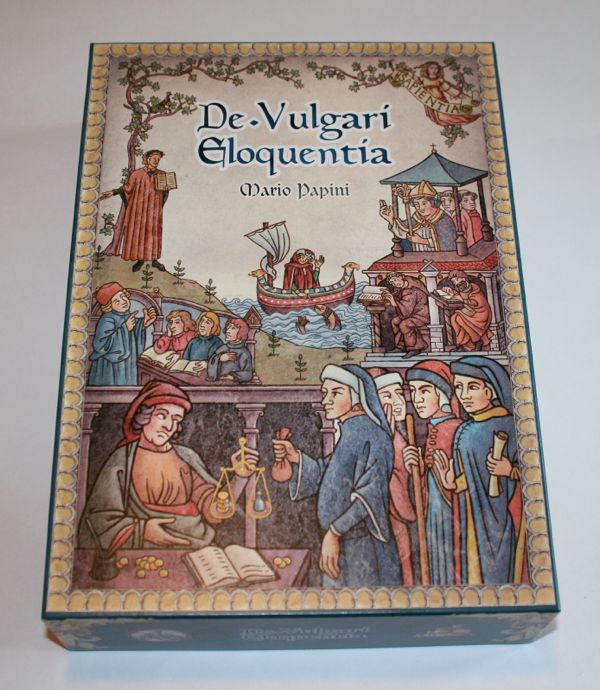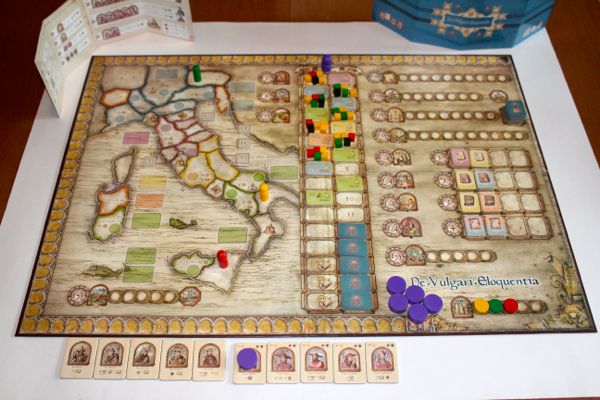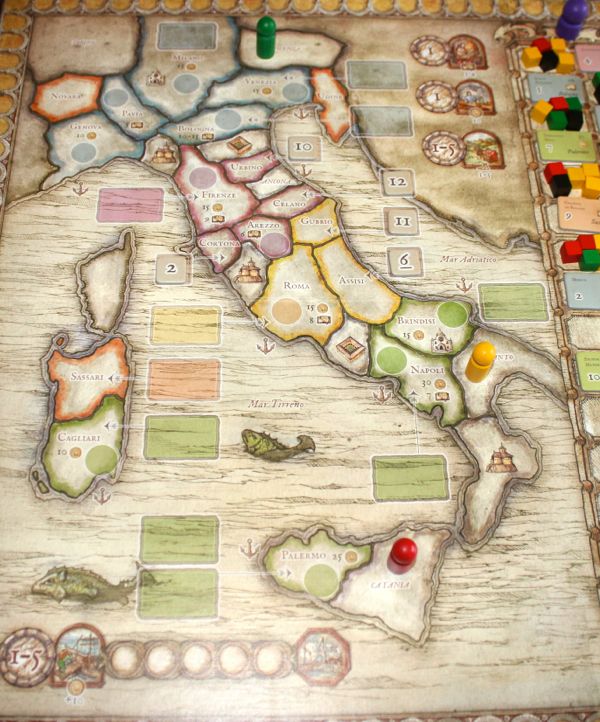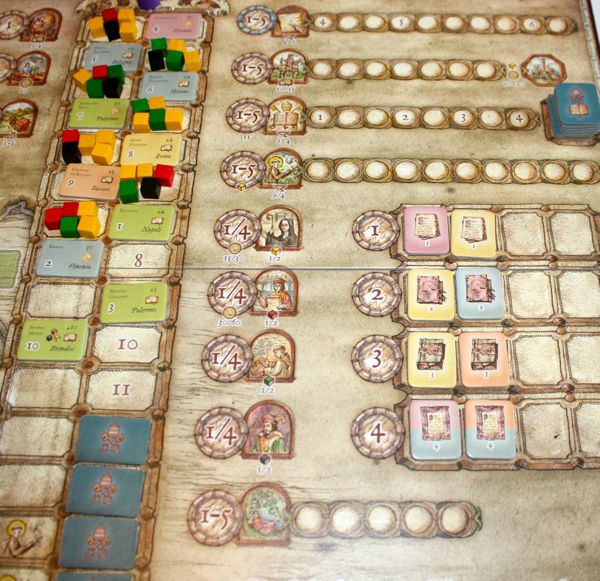Loosely translated, De Vulgari Eloquentia (which is Latin) means The Common Language. Google literally translates it as Ordinary Eloquence.
In either case, that phrase sets up the theme for this game. You get to help develop the language of the common people in Italy in the late Middle Ages. That’s the time when St. Francis and Dante were writing important stuff.

I’ve played (and lost) the 2-player version of De Vulgari Eloquentia (DVE, for short, from now on) twice. You can play with 2-5 players. My second game (after both of us knew better what we were doing) lasted about an hour. If you add more players, expect to add more time – perhaps half an hour per player.
Let’s take a look at the board and most of the rules, so you can get an idea if you’d like to try DVE for yourself. Spoiler alert (an overused phrase): I think you will.
What Does the Board Look Like?
Below is an overview of the only board in DVE. There are no smaller side boards or player mats that so many other games seem to have these days.

It’s set up for a 3-player game. Several features of the setup give this fact away. There are obviously 3 player colors – red, yellow, and green. In addition, the clumps of colored cubes on the central round-marking track are in groups of five. Also, there are 2 manuscript tiles in each of the four rows at the right. If there were more or fewer players, these numbers would change.
There are three major sections of the board and a lot of minor areas. You can see the map of Italy and nearby islands on the left. Down the center is the round track mentioned above. At the right are various types of tracks, most of which give you victory points (called Vulgare Points in the directions).
At the lower right is the turn order track. You go first if you’re last on the Knowledge Track which starts near the turn order track and goes clockwise around most of three edges of the board. This is not a victory point track and is not numbered as such, but it should be. You’ll probably end up using it as one at the end of the game (as we did), but there are no 5, 10, 15, etc. point designations along the way. There are a few other numbers on the track, but they’re there for a different reason.
Each round, you move the purple event pawn down the center track. If there is a rectangular region tile in the row, you place it on the appropriate space on the board. These tiles give special favors to the first, and only the first, player to enter that region.
If there are cubes in that row, you might be able to collect one or more of them by using some of your 5 purple action points – the 5 purple circles currently resting near the turn order track. Each player reuses these after the previous player is done with them, so there are only 5 in the game – not 5 for each person.
What Can I Do on My Turn?
One common thing to do each turn is to move your pawn on the map. If you only move to an adjacent region, you only spend 1 action circle, placing it onto the movement space which is the bottom circle between the map and the round track.

You can use more than one (all 5 if you like) action circles there and move the corresponding number of regions. Moving more than one space costs you 10 coins (Ducati), however. (No coins are shown in any of these pictures.)
If you move to a region that gives you special favors, you collect them immediately. You might get money or knowledge or both. You can only collect once from each region, so you put a small circle (like those on the turn order track) from your supply onto the circle in that region to indicate you’ve already been there, done that.
Below the map is the oriental trading track. You start the game as a merchant (and can remain one throughout the game). If you use action points to move up the orient track and get to the end of it (which would take 2 turns at the minimum), you collect double the funds from any region offering them, as long as you are still a merchant.
The thing is: You don’t have to be a merchant forever (though it’s possible to win the game as one). You can progress through the Roman Catholic hierarchy and may eventually become Pope!
Some of the regions show buildings. If you enter a Convent, you can become a Friar. You give up have your money and choose of one 5 possible named Friar tiles (shown in the setup picture above at the lower left). Each Friar gives you differing special privileges.
Once you are a Friar, you can later enter a region with a Cathedral to become a Cardinal. If you can afford the 40 Ducati and either a red or a black cube, you give up your Friar tile and replace it with the Cardinal tile of your choice (shown next to the Friar tiles above).
At the end of the game, no matter which vocation you have, if you can afford to do so, you can “upgrade” from Merchant to Banker, Friar to Monk, Cardinal to Camerlengo, or Cardinal to Pope (which costs more than Camerlengo, and there can only be one).
There is a third type of building on the map – the Abbey. Normally, you have to pay 15 Ducati to get a yellow cube (an Abbess). While in an Abbey, that cost is forgiven. If you have previously collected any green cubes (each is an Amanuensis, a secretary) and placed them in front of your screen, you can convert all of them into point cubes or cash.
If you convert them to points cubes, you place them behind your screen which is where you keep any other cubes and VP tiles you collect.

Other actions you can take each turn are moving along the tracks shown above and (as already mentioned) collecting available yellow, red, green, and black cubes.
You can move along the top track, called the Riddle from Verona, on the right side of the board (see picture above) only when your pawn is in a blue (northern) region. This track awards you 4, 5, or 6 points at the end of the game, depending on which number you have hit by then.
The track below is the Messenger. It’s very specific and seems difficult to achieve its goal. If you get all the way to the end by using action points and paying the fee in coins and yellow cubes, you get 15 knowledge points if done by round 7 or 10 knowledge points in round 8 or later. You only get this knowledge when you enter Bologna.
You can only use the next Papal Library track after round 11. Only once per game and depending on how far down the track you have progressed, you can take 1-4 tiles from the nearby pile and place one of them behind your screen. The tiles give you straight up VP.
The Canticle of the Sun track can be worth a lot of points (9 or 4), but it’s tricky to move along it at all. If you look back at the map picture, you’ll see 5 small tiles associated with 5 of the regions. The tiles are numbered 2, 6, 10, 11, and 12. They were randomly placed at the beginning of the game. The numbers do not change from game to game.
If you get to the region associated with 2 during the 2nd round, you can use action points to move along the Canticle track. If you get to the region associated with 6 during the 6th round, you can do the same. The regions with 10, 11, and 12 are treated similarly. (I have yet to move up this track. This is probably why I lost my second game.)
Below the Canticle track are the 4 circles where you can use action points to collect cubes. Sometimes there is a cost in Ducati. Next to these spaces are the 4 manuscript rows. From top to bottom, each is worth 1 to 4 VP. You have to both be located in a region on the map of the same color as the manuscript and (for the 2-4 point manuscripts) must have passed the number 2, 3, or 4 on the knowledge track before you can collect one of these tiles. This is actually not as hard as it sounds.
Below this is the rest track where you can place any action point circles you can’t or don’t want to use elsewhere. You can use this track to override the turn order track.
How Does DVE End?
The last 5 rounds on the center track have face down tiles that indicate the health of the current Pope. Three of them are white (he’s okay). Two of them are red (he’s ill and he’s dead).
These tiles are randomly placed. When you uncover the second red tile, the Pope dies and the game ends. Everyone goes back to Rome (on the map) and takes one more turn.
Final scoring includes the following. If you can afford to upgrade your current status (mentioned earlier), can do so and gain VP. You can get more VP from leftover cubes, from tiles with VP on them, and from coins. You might also get VP from the Riddle from Verona and the Canticle of the Sun tracks. The player with the most points wins.
Will I Like De Vulgari Eloquentia?
As I said earlier, I’ve only played it twice, but I know already this is a game I really like. I think you’ll like it too. I think it probably plays even better with 3 or 4 players. I’ll reserve any judgment about a 5-player game until I’ve played one.
There are several distinct paths you can take during the game. You can remain a Merchant all your life. you can be a Merchant for a while and then become a Friar. Maybe you stop there, or maybe you move up to Cardinalship. If you’re good at collecting cubes, you could be Pope.
In the first game I played, I lost to a Pope. In the second game, I lost to a Merchant/Banker. Okay, so maybe the other guy was just better at DVE than I am.
This is one of the reasons I’d really like to play again with at least three players. Maybe I could at least beat the third guy.
Get De Vulgari Eloquentia at Amazon today!
